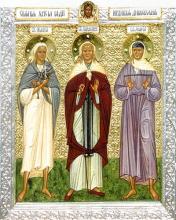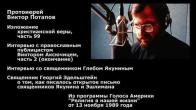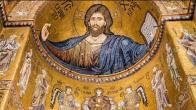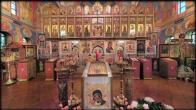You are here
Blessed Maria of Diveevo
26 August / 8 September
 Blessed Maria (Maria Zakharovna Fedina) was born into a family of peasants in the Tambov District. Since childhood, she loved to be alone and to pray. Maria’s father died when she was 13, and her mother Pelagia died one year later. Left an orphan at the age of 14, she endured hunger, and wandered between Diveevo and Sarov. She walked about in “lapti” [woven bast sandals], often ragged and torn and without leggings, ignoring the weather – winter and summer, in cold and heat, in times of drought and in rainy autumn. Once during Passion Week she slogged along flooded, impassable roads, up to her knees in water mixed with dirt and snow, to get to Sarov. Seeing her, a peasant driving a cart took pity on her and offered to take her the rest of the way, but she refused. In the summer, Maria apparently lived in the woods, for when she would come to Diveevo, her body was covered with ticks, and many of her wounds were festering. They used to say about Maria Ivanovno that before coming to Diveevo, she had spent 40 years in constant prayer under a bridge. Mother Abbess Alexandra would often send to Maria Ivanovna for answers to various perplexing questions.
Blessed Maria (Maria Zakharovna Fedina) was born into a family of peasants in the Tambov District. Since childhood, she loved to be alone and to pray. Maria’s father died when she was 13, and her mother Pelagia died one year later. Left an orphan at the age of 14, she endured hunger, and wandered between Diveevo and Sarov. She walked about in “lapti” [woven bast sandals], often ragged and torn and without leggings, ignoring the weather – winter and summer, in cold and heat, in times of drought and in rainy autumn. Once during Passion Week she slogged along flooded, impassable roads, up to her knees in water mixed with dirt and snow, to get to Sarov. Seeing her, a peasant driving a cart took pity on her and offered to take her the rest of the way, but she refused. In the summer, Maria apparently lived in the woods, for when she would come to Diveevo, her body was covered with ticks, and many of her wounds were festering. They used to say about Maria Ivanovno that before coming to Diveevo, she had spent 40 years in constant prayer under a bridge. Mother Abbess Alexandra would often send to Maria Ivanovna for answers to various perplexing questions.
No one ever heard from her any groan of despondency, annoyance or complaint about human injustice. Because of her God-pleasing life and her enormous humility and patience, the Lord Himself glorified her before men. They began to notice that what she would say or warn against would come to pass, and that God’s grace would come down upon people with whom she would stay.
Blessed Praskovia Ivanovna, foreseeing her death, would say to her friends, “I am still sitting at my post at the mill, but another, who is still walking about, will later sit down.”
On the day Blessed Paraskeva of Sarov died, the nuns drove blessed Maria out of the Monastery, as they were greatly vexed by her eccentricities. However, a peasant who came to the monastery said, “What a servant of God you have cast out of the monastery; she just told me my entire life, and all of my sins. Bring her back to the monastery, or you will lose her forever.” They immediately sent messengers to go after Maria Ivanovna, who then returned to the monastery.
When they would ask her why she was known as “Ivanovna,” she would reply, “All of us blessed ones are Ivanovny, [children] of [St.] John the Forerunner.”
Maria Ivanovna would speak rapidly and a great deal, sometimes in verse, and sometimes uttering obscenities, especially after 1917; hidden in her words were prophetic denunciations. There is eyewitness testimony that many times, by the prayers of the Blessed One, who herself greatly suffered a great deal of sickness and unfortunate circumstance that she had brought on herself, the Lord healed the suffering. During the difficult years of revolutionary trials for Russia, the flood of people in need of her prayerful help and instruction increased. Her prophecies and predictions helped many people escape danger and perdition, and find the right path in difficult circumstances.
The Soviet authorities initiated a campaign of persecution against the Blessed One, and forbade her to receive visitors. After the Monastery was shut down in 1927, Maria Ivanovna found refuge in homes of believers. Shortly before her death, she was arrested and interrogated, but concluding that she was insane, her interrogators released her. Foreseeing that years of trials in camp, exile, and atheism were to come, Maria Ivanovna strengthened the resolve of the monastery’s nuns, predicting the rebirth of the St. Seraphim — Diveevo Monastery.
A true ascetic struggler and God-pleasing person, she possessed gifts of healing and clairvoyance. The nuns told of how on the night of July 4-5, 1918, the night the Royal Family was martyred, Maria Ivanovna was greatly agitated, screaming “They are bayoneting the Princesses!” She was in an awful frenzy, and only later did what she was screaming about become clear.
After the monastics were dispersed, she lived at first in the village of Puzo, and then with the blessing of Abbess Alexandra, she was moved to Elizarovo. There she lived unto the Spring, when she was moved to Diveevo, at first to live with a deaf mute and his sister, and in 1930, to a little hamlet near the village of Pochinkok, and ultimately to Cherevatovo, where she reposed on September 8, 1931. Maria Ivanovna was interred at the village cemetery.
Relics in cathedral - monthly calendar
| S | M | T | W | T | F | S |
|---|---|---|---|---|---|---|
|
|
|
|
1
|
2
|
3
|
4
|
|
5
|
6
|
7
|
8
|
9
|
10
|
11
|
|
12
|
13
|
14
|
15
|
16
|
17
|
18
|
|
19
|
20
|
21
|
22
|
23
|
24
|
25
|
|
26
|
27
|
28
|
29
|
30
|
31
|
|
PARISH LIFE
Address of our Cathedral
While all the materials on this site are copyrighted, you may use them freely as long as you treat them
with respect and provide attribution on the Russian Orthodox Cathedral of St.John the Baptist of Washington DC.









